Home > Oasis of Peace > Projects & Outreach > Children’s Educational System > Update on the Children’s Educational System
Update on the Children’s Educational System
Thursday 10 January 2008

Based on an interview with NSWAS School Principal Anwar Dawood
Enrolment and staffing
There are currently 180 children in the school system. At the Primary School level there are 130 pupils, with fifty more in the early childhood education. Recently there have been new applications for the second and third grades. This year, for the first time, there are children from the nearby kibbutzim of Nachshon and Gezer, and we can expect more students from there next year. This is a welcome development, in that it connects the school more with communities in the area.
The school faculty has 18 full and part time teachers, and there are ten more educators at the early childhood education level. In the latter, there have been some recent changes. There is a new director for the early childhood level, Nadira Aasus. She is well qualified for the role, and is currently responsible also for early childhood education systems in Lod, Jaffa and Jisr az-Zarka. Another staff change in the Early Education group: the resignation this winter of kindergarten teacher Bernadette Layous. A replacement is being sought.
Recent improvements
Over the summer, we made various improvements to the school facilities - painting, redecorating and, in particular getting rid of some old asbestos roofing over some of the auxiliary buildings. We have also been grateful for the new computers that arrived towards the end of last year, as well as for a multimedia projector, provided by the British Friends. In the future, we would like to add playground equipment that is suitable for the older children and some sports equipment such as a table tennis board.
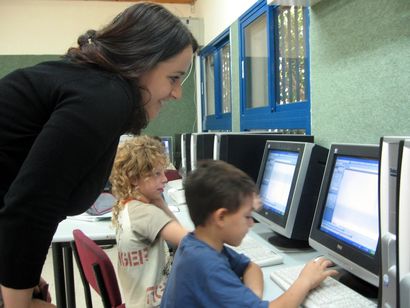
Projects
The first few months of the school year have featured several important projects.
The “environmental school” project
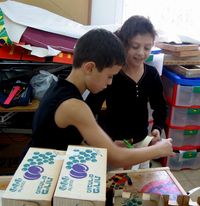
This year we began a new project called “the environmental school”, which expands on the ecology projects of earlier years, with the idea to make the school as environmentally conscious as possible. It involves the children and teachers at all levels, and tries to inculcate environmentally friendly principles, such as recycling, energy conservation, respect for the school environment, etc. A special teacher, Michal Moses, comes in to instruct the children on these topics. There is also an agricultural unit, which involves learning how to grow crops. Our Regional Council (equivalent to a county) is trying to encourage schools in the area to be more environmentally friendly and, as an incentive, has created a “Green School” program. We are now checking with the Mateh Yehuda Regional Council about the possible advantages to us of joining this program.
Archaeology project
The archaeology project begun in earlier years is continuing this year too. Fourth, fifth and sixth grade classes are taking part in the project. A four-day workshop was recently conducted with village resident Gideon Suleimani from the Antiquities Authority and other archaeologists from outside. There will be similar workshop in March 2008. The current theme is preservation work on the Byzantine mosaic that was uncovered by the children, with the eventual aim of including the site in the visit programs of the Jewish National Fund and the Antiquities Authority. This will serve the interests of NSWAS as it will bring visitors to the village too.
Zoo Lab
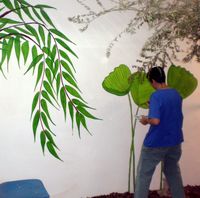
School staff members Voltaire Shamshoum, Tsipi Zohar and volunteer Felix Spira have been hard at work converting a classroom into a “Zoo Lab”. This has involved creating, outfitting and decorating an indoor enclosure with access to a cage outside. We have already brought in rabbits and other small animals. Voltaire, with substantial experience in caring for and teaching about animals, is currently taking an enrichment course in the field. The aim will be to involve the children in looking after the animals as well as learning about them.
Healthy school

The healthy-school project involves teaching the children the importance of exercise, healthy lifestyle and proper nutrition. The children are reminded of these things every morning on their arrival, since the school day starts with fifteen minutes of exercise and breakfast, including a discussion with the health teacher about nutritious food.
Active Breaks
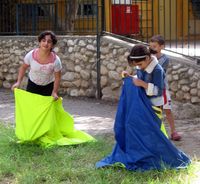
As in previous years, we look upon breaks as an opportunity to extend instruction, in an informal way. This year, breaks include sport and social games, with teachers and children working together.
Home hosting
One project that helps to create strong community connections and mutual understanding of the diverse home environments from which the school children come is the arranging of visits by the students to classmates in other villages. Very often this happens informally; this year, however, we are working to make sure that each child does visit children in another village.
Visiting other schools
Because the NSWAS School is so unusual, our students can benefit from an acquaintance with children in other – more mainstream - schools in our area. This year, we are working to arrange a visit by each of our classes to some other local school. Another way of meeting other school children is in sports competitions. There was a recent competition between our school and a school in the nearby town of Beit Shemesh.
Field Trips
Outside activities occupy an important place among the activities of the school. This year the children visited the nearby Trappist Abbey of Latroun to take part in olive-picking, and then saw how the olives were pressed to make oil.
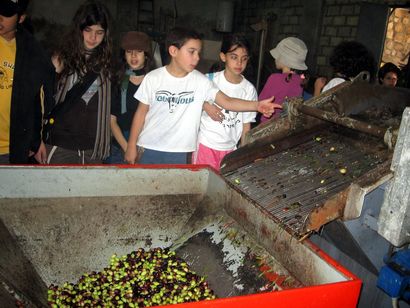
The third and fifth grade classes visited museums in Jerusalem and Ramat Gan.
Holidays
Almost every year, besides the usual celebration of holidays at the school, there is an opportunity to hold a celebration in common, and this year we celebrated Eid al-Adha, Christmas and Hanukah together. The children prepared plays and musical performances for an evening of entertainment, which was held in the concert hall of the Abbey at Latroun.
Teacher education
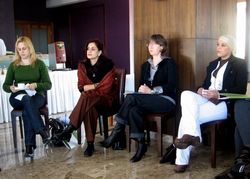
All of the teachers at the school have proper certification as educators in their subjects, with the exception of two who are candidates for certification and are currently completing their relevant courses. In addition, however, the special challenges of bi-national education require ongoing teacher education and enrichment. Recently we conducted a three-day training workshop with the School for Peace, and we have also began a series of lectures aimed at defining social needs in education, as a basis for curriculum planning. The first, by Nurit Peled-Elhanan, looked at the representation of Arabs in Israeli schoolbooks. Parents and members of the NSWAS educational institutions are also invited to attend. The series is meant to serve as a basis for developing additional curricula specifically appropriate to a bi-national school.
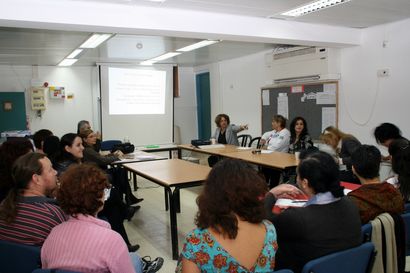
Challenges and needs
Curricula and texts
One of the problems we face at the school is a lack of suitable texts for teaching languages. For instance, in teaching Arabic to Jewish first-graders, we have had to use books that are actually written for seventh graders. Language books are geared either for native speakers or for students of a foreign language: two quite opposite functions. We need age-appropriate texts for students who are somewhere in the middle. In a similar way, we need to consider alternative texts for subjects like geography, history and literature.
Expansion
Our most significant challenge is to return the school to an enrolment of about 250 students (+ another 50 in the early childhood education system). We would like again to have two classes at each grade level. To this end, we are making an ongoing attempt to advertise the school and to involve parents in this effort too. There is a potential to reach new places like Modi’in and Beit Shemesh, and to bring Jews (rather than only Arabs, as now) from Ramle and Lod. We think it would also be worthwhile to try attracting students from further afield. And, as mentioned, we are encouraged to see students beginning to arrive from adjacent communities like Nachshon and Gezer.
Finances
A school of our size receives from the Education Ministry a budget for teaching that covers 130 hours a week. In a mainstream school, this is supposed to constitute 50% of the budget. However, at our school there are 400 weekly teaching hours. The education of a child in Israel is supposed to cost NIS 15,000, whereas at our school it costs NIS 31,000. The discrepancy is due to smaller classes and more teachers. We are still awaiting payment from the Ministry for all of last year as well as this year, but hope that this will come through soon.
Due to creative arrangements we have made with our regional council (our friends’ associations have provided them with school buses), we are managing to offset the high transportation costs. But we still need to pay NIS 70,000 in past debts.
Our strategic intent is to run the school without incurring debt and to work with the available budget.
Outside contacts
There have been some recent favourable press contacts, including a report on the school by the Israel Broadcasting Authority’s Arabic service, and a request to write a weekly column for a journal in nearby Ramle.
Hand in Hand schools
Hand in Hand, the Association for Bilingual Schooling, opened its first school in 1998, with active encouragement and help from NSWAS and the use of our school as a training model for teachers. Since then, two more schools have opened, and the association is trying hard to establish additional ones. In NSWAS, we see the efforts of Hand in Hand as a very welcome extension of our longstanding aim to establish the legitimacy of binational education in Israel. There is no formal affiliation or collaboration between Hand in Hand and our school, though informal contacts exist. For example, representatives from our school attended the inauguration of the association’s new school in Jerusalem. A management-level working meeting is planned to discuss possibilities for further cooperation.
NSWAS school principal Anwar Dawood notes that there are certain differences between the schools, as reported by parents whose children attended the Jerusalem Hand in Hand school and then switched to our school. Part of the difference is well-expressed in the choice of terminology for the schools, i.e. “bilingual” versus “binational”. Perhaps because the NSWAS school is grounded in a bi-national community, which attempts to create equality at every level, the tendency here is to look at language as only one component in the encounter between Jews and Palestinians.
International connections
Two NSWAS teachers have travelled abroad on missions for the primary school recently: Reem Nashef visited Finland to explore a possible connection with schools there and Raida Khatib visited the UK in order to continue our connection with the Woodstock School in Oxford. We are optimistic that these efforts will bear fruit in the form of enriching and lively connections between our pupils and their counterparts abroad. Another possibility that is now being explored is a joint exhibition of drawings by students from our school and children in Palestine.
Optimism for future
Anwar Dawood feels that the school is developing very favourably and is optimistic for the future. He reports that there is a high level of confidence in the school within the community; that parents are expressing satisfaction; and that there is an evident willingness to help and contribute time on the part of parents and NSWAS members. He wants to convey thanks on behalf of the entire school community to all those who continue to provide support, both locally through voluntary efforts and overseas through moral support and monetary assistance to the NSWAS educational system.